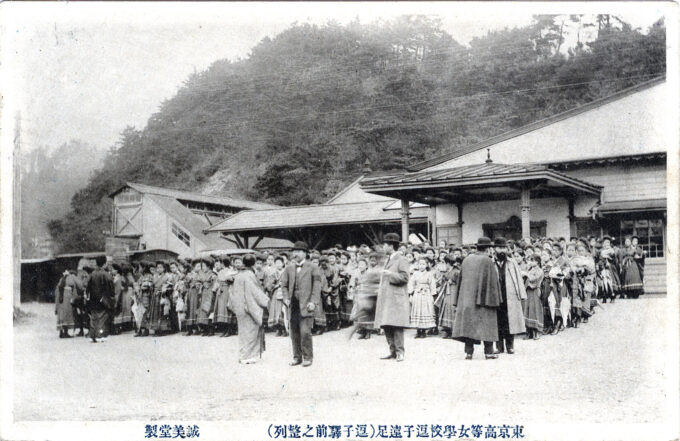
A Tokyo high school’s class excurision to the Miura peninsula in line outside Zushi Station, Zushi, c. 1910. Shūgaku ryokō [lit., “school excursion”] are educational overnight trips organized by elementary and secondary educational institutions to provide students with study, recreational and group labor opportunities they would otherwise never experience. Today, almost all schools throughout Japan offer shūgaku ryokō or a similar group activity to students in their final or penultimate year of high school.
See also:
“The seashore of Zushi”, Miura Peninsula, near Tokyo, c. 1925.
Hayama Beach, Kamakura, c. 1910.
Kamakura Station, c. 1910.
“All the staff and students of Kinjo Girls’ School”, Nagoya, c. 1920.
“Student at Tokyo Army Aviation School” propaganda postcard, c. 1940.
“Shūgaku ryokō [school excursions] were originally established by Tokyo Normal School, a national teacher training school, in the mid-Meiji period.
“At the beginning, these excursions were educational trips involving overnight stays, and combined military-style marching, called kōgun [‘forlorn force’], with naturalistic observation. Subsequently, normal schools and middle schools nationwide adopted this type of school trip.
“Later, marching was replaced with train travel, and military training was separated from school excursions, resulting in a more touristic form of shūgaku ryokō which was then maintained by schools around Japan through the Meiji, Taishō and Shōwa periods.
‘Although a boom in shūgaku ryokō in Manchuria and Korea occurred after the Russo-Japanese War (1904–1905), and a form of shūgaku ryokō ostensibly aimed at the veneration of deities and ancestors emerged under the wartime regime, touristic practices and motivations continued to underlie the practice.
– “School Excursions and Militarism: Continuities in Touristic Shūgaku Ryokō from the Meiji Period to the Postwar”, by Takeshi Soyama, Japan Review, No. 33, 2019

